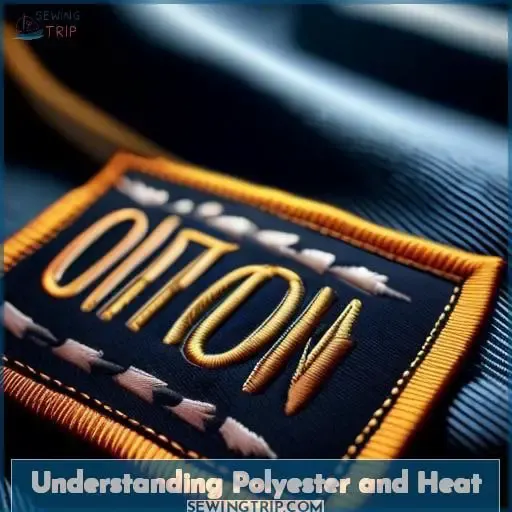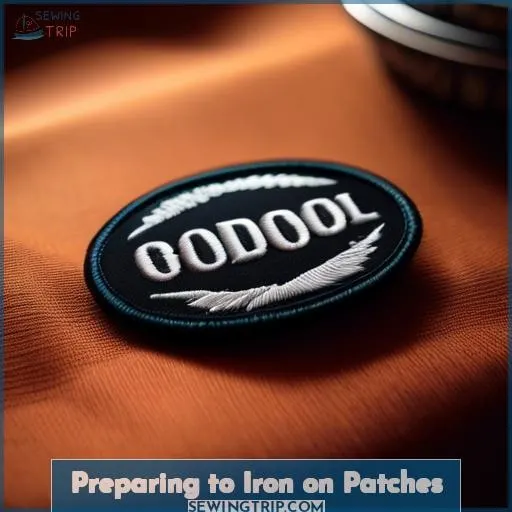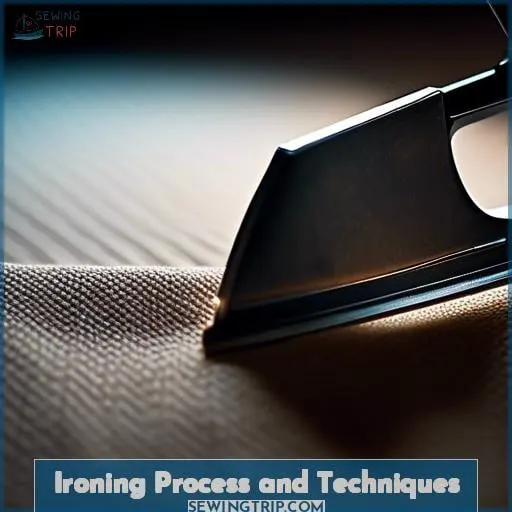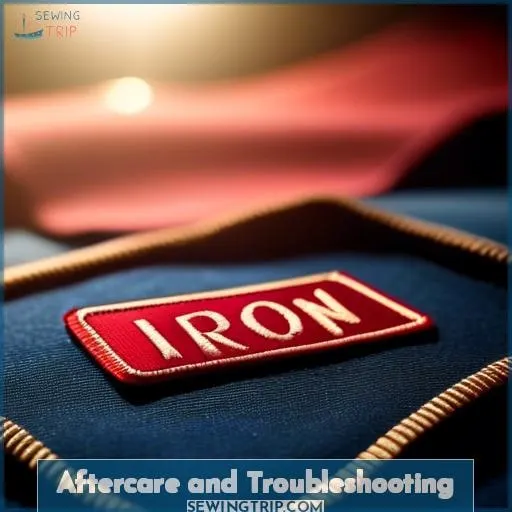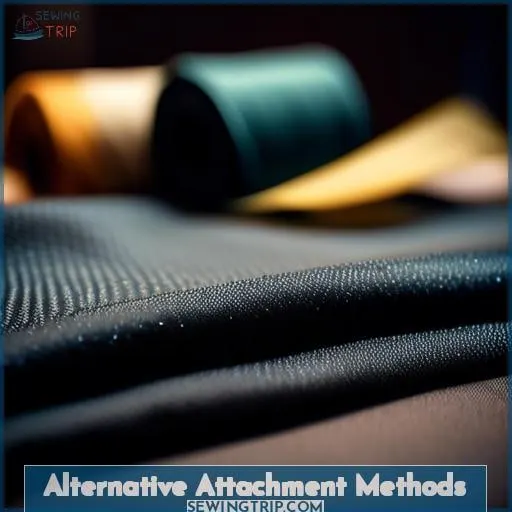This site is supported by our readers. We may earn a commission, at no cost to you, if you purchase through links.
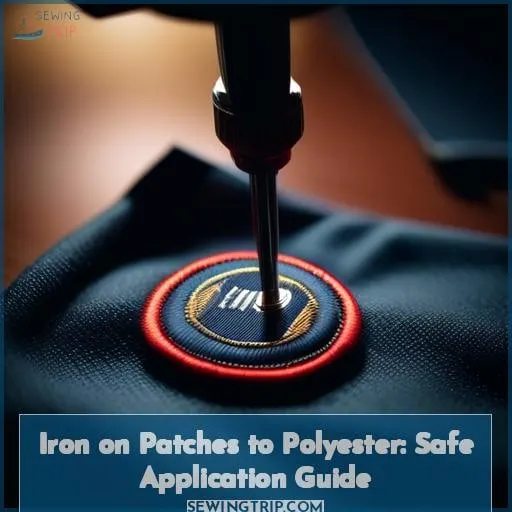 Nearly 60% of the world’s clothing is made from polyester, a fabric known for its durability and versatility.
Nearly 60% of the world’s clothing is made from polyester, a fabric known for its durability and versatility.
If you’re looking to personalize your polyester garments with iron-on patches, you’re in luck. With the right technique, you can safely apply patches without damaging the fabric.
This guide will walk you through the steps to ensure your patches adhere perfectly, from setting the right iron temperature to post-application care.
Embrace the innovation of fabric customization and master the art of ironing on patches to polyester.
Yes, you can iron on patches to polyester, but it requires careful heat management to prevent damage to the fabric. Use a low heat setting on your iron and place a thin barrier, like parchment paper or cotton cloth, between the iron and the patch to protect the polyester.
Table Of Contents
Key Takeaways
- Polyester is sensitive to high heat and can melt or scorch, so it’s important to use a low to medium heat setting when ironing on patches.
- Before ironing on a patch, the polyester fabric should be clean, dry, and wrinkle-free to ensure proper adhesion of the patch.
- A protective barrier, such as parchment paper, should be placed between the iron and the patch to shield the polyester from direct heat.
- After ironing, the patch and fabric should be allowed to cool completely before testing the edges to ensure the patch is securely adhered. Sewing around the edges can provide additional security.
Understanding Polyester and Heat
When applying iron-on patches to polyester, it’s crucial to understand the material’s heat sensitivity.
Polyester, a synthetic fabric, can be prone to melting or scorching under high temperatures. To safely embellish your polyester items with patches, you’ll need to use a low to medium heat setting on your iron and place a protective barrier, such as parchment paper or a thin cloth, between the iron and the patch.
This ensures the patch adheres without damaging the fabric.
Material Properties
Understanding the properties of polyester and its interaction with heat is crucial when applying iron-on patches. Polyester, a synthetic fabric, is known for its durability and resistance to shrinking and wrinkling.
However, it has a lower melting point compared to some other fabrics, which necessitates careful handling when exposed to high temperatures, such as during the iron-on process.
-
Heat Sensitivity: Polyester can withstand temperatures up to 150°C (302°F) but is prone to melting under excessive heat. This characteristic requires the iron to be set at a low to medium temperature to avoid damaging the fabric.
-
Flame Retardants: Some polyester materials are treated with flame retardants to enhance their resistance to fire. While this treatment can make polyester safer in certain environments, it’s important to consider this factor when applying heat.
-
Material Alternatives and Blends: Polyester is often blended with other fibers, such as cotton, to improve certain properties like comfort and heat resistance. These blends can affect how the material reacts to heat and should be considered when choosing iron-on patches and the appropriate application method.
By understanding these properties, you can ensure a successful application of iron-on patches to polyester items, enhancing their appearance while maintaining the integrity of the fabric.
Heat Sensitivity
Understanding the heat sensitivity of polyester is crucial when applying iron-on patches. This synthetic material, while versatile and durable, can be particularly vulnerable to heat.
To ensure patch durability and maintain the integrity of your polyester items, it’s essential to use low heat settings during application. Adhesive alternatives, such as fabric glue, offer a safe and effective method for attaching patches without the risk of heat damage.
Always prioritize material compatibility and safety concerns to avoid damaging your garments. Proper patch maintenance, including gentle washing and avoiding direct heat, will extend the life of your embellished items.
By carefully selecting iron-on patches and considering heat-activated patches’ compatibility with polyester, you can express your style safely and innovatively.
Preparing to Iron on Patches
Before you start ironing on patches to your polyester items, it’s crucial to ensure the fabric is clean and completely dry. This preparation step is key to achieving a strong bond between the patch and the material.
Next, carefully position the patch in the desired location on your item, as this will be where it permanently resides once ironed on.
Cleaning and Drying
Given the sensitivity of polyester to heat, it’s crucial to start with a clean and dry base before applying an iron-on patch.
Pre-treatment options like washing the fabric ensure it’s free from oils or dirt that could affect the adhesion of the patch. Considering fabric compatibility is key; polyester, while heat-sensitive, can safely receive patches with the right precautions.
The patch material impact is also significant; choose patches designed for heat application to avoid damage. Drying time impact can’t be overstressed; the fabric must be completely dry to prevent steam or moisture from affecting the patch’s adherence.
Different patch types offer various adhesive qualities, but for polyester, a warm iron and careful application ensure a secure bond without damaging the fabric. Using cloth or fabric glue as a barrier can protect both the patch and the polyester material during application.
Patch Placement
When it comes to patch placement on polyester, envision the transformation as you position your patch for an aesthetic upgrade.
- Lay your polyester item flat, free of wrinkles, creating a smooth canvas for your design.
- Carefully position the patch, considering the location for maximum visual impact.
- Use parchment to shield the patch from direct heat, setting your iron to a temperature safe for polyester—typically low heat—to avoid any mishaps with multiple layers.
Ironing Process and Techniques
When applying iron-on patches to polyester, it’s crucial to adjust your iron to the right temperature. Set your iron to a low or medium heat setting and use a pressing cloth or parchment paper as a barrier to protect the polyester fabric.
Apply firm pressure with the iron for about 10-15 seconds, ensuring not to slide the iron around, which could distort the patch or damage the fabric.
Iron Settings
Once you’ve prepped your polyester fabric, it’s time to focus on the iron settings for attaching your custom patches.
Set your iron to a low to medium heat to ensure fabric compatibility and prevent damage. A temperature guide suggests around 270 degrees Fahrenheit for polyester, which is often marked as cotton on irons.
Use parchment paper as a barrier for safety measures and even heat distribution, protecting both the patch and the fabric. Optimal settings are crucial; too high and you risk melting the material, too low and the patch may not adhere properly.
Applying Pressure
Given the guidelines and the focus on the subtopic of ‘Applying Pressure (Ironing Process and Techniques)’, it’s crucial to understand the balance between applying the right amount of pressure and ensuring even heating when attaching iron-on patches to polyester materials.
The process involves setting your iron to a low to medium heat setting, as polyester is sensitive to high temperatures. Before you begin, ensure the fabric is clean and positioned on a flat, heat-resistant surface.
Place the patch in the desired location on the polyester item. Cover it with a thin barrier, such as parchment paper or a thin cloth, to protect the fabric and patch from direct heat.
Press the iron down firmly over the patch, applying steady pressure. Use slow, circular motions to distribute the heat evenly across the patch, focusing on the edges to ensure complete adhesion. This technique helps activate the adhesive on the back of the patch without damaging the polyester fabric.
The duration of this step is critical; typically, 30-40 seconds of pressure is sufficient, but patience is required to achieve the best results. After applying heat, allow the patch and fabric to cool completely before testing the edges to ensure the patch is securely attached.
This method, emphasizing even heating and careful pressure application, ensures that the patch adheres well to the polyester without causing damage to the material. It’s a blend of art and science, requiring attention to detail and a gentle touch.
Whether you’re working with patches from a custom patch manufacturer for a unique project or applying pre-made patches to personalize your items, the process is the same. High-quality materials and the right technique will result in a durable, aesthetically pleasing finish that expresses your individual style or brand identity.
Barrier Use
When applying an iron-on patch to polyester, using a barrier is crucial to protect both the patch and the fabric from direct heat, which could cause damage.
- Barrier Placement: Carefully position a piece of parchment paper or a thin cloth over the patch. This acts as a shield against direct heating, ensuring the patch edges don’t get singed.
- Barrier Size: Ensure the barrier covers the entire patch and a bit of the surrounding area to prevent any accidental direct contact with the iron.
- Barrier Effectiveness: The barrier helps distribute the heat evenly, reducing the risk of melting the polyester fabric or damaging the patch.
- Barrier Removal: After applying heat, gently lift the barrier to check the adhesion. If the patch isn’t fully secured, replace the barrier and apply heat again.
Aftercare and Troubleshooting
After applying an iron-on patch to polyester, it’s crucial to let the area cool down completely before testing the edges for secure attachment.
If the edges lift, you may need to apply additional heat for better adhesion.
For added security and to ensure the longevity of your patch, consider sewing around the edges after the patch has cooled.
Cooling Down
After applying your iron-on patch to polyester, it’s crucial to let it cool down to ensure a secure bond.
| Step | Action |
|---|---|
| 1 | Remove iron and let patch sit |
| 2 | Wait for patch and fabric to cool |
| 3 | Test edges for secure adhesion |
| 4 | If loose, reapply heat briefly |
Cooling time is essential for the materials to bond at the right temperature, ensuring safety and the longevity of your embellishment.
Edge Testing
After ironing on your patch, it’s crucial to check its edges for secure adhesion. This step ensures your patch won’t peel off prematurely, maintaining the integrity of your design.
If you notice any lifting, reapply heat carefully to those areas. Remember, patience is key to preventing heat damage and preserving both the patch’s and the fabric’s durability.
This method respects material compatibility, ensuring your embellished items remain both stylish and intact.
Additional Security
To ensure your iron-on patches provide an extra layer of security on polyester fabrics, follow these steps:
- Conduct a pre-ironing test on a small, inconspicuous area to check for heat sensitivity.
- Iron the back of the patch after application to reinforce the adhesive bond.
- Allow ample cooling down time before testing the patch’s adhesion.
- Consider a fabric glue alternative for materials that are sensitive to heat.
Alternative Attachment Methods
When you’re looking to attach patches to polyester without the use of an iron, you have a couple of safe and effective methods at your disposal.
You can opt for the covering technique, which involves using a thick, strong material to evenly distribute heat and prevent damage to the polyester.
Alternatively, fabric glue offers a no-heat solution by applying the adhesive directly to the patch and then attaching it to your garment.
Both methods ensure your polyester remains intact and undamaged.
Covering Technique
Once you’ve allowed your newly applied patch to cool, consider the covering technique as an alternative method for attaching patches to polyester. This method involves using a thick, strong material to protect the polyester while evenly spreading the heat.
| Step | Material | Purpose |
|---|---|---|
| 1 | Thick material | Acts as a heat barrier |
| 2 | Strong material | Ensures durability |
| 3 | Stretch material | Provides flexibility |
Stretch the chosen material over the patch, outline its shape, and apply heat. This method ensures that the polyester underneath won’t be damaged by the heat, offering a safe and effective way to attach your patch.
Fabric Glue Usage
Transitioning from the covering technique, let’s delve into fabric glue usage—an alternative that’s both innovative and practical.
- Glue Application: Apply a thin, even layer to ensure the patch adheres well without stiffening the fabric. Excessive glue may seep and cause residue.
- Glue Precautions: Work on a hard surface and avoid glue on skin or surroundings. Use non-toxic, acid-free glue for safety.
- Glue Removal: If excess glue appears, act promptly. Once dried, methods like scraping or using acetone can help remove the residue.
Frequently Asked Questions (FAQs)
Can iron-on patches be safely applied to polyester clothing that has a waterproof coating or treatment?
Iron-on patches can adhere to polyester with waterproof coatings.
You must use low heat and a protective barrier, like parchment paper, to prevent damage.
How do you ensure that iron-on patches adhere to stretchy polyester fabrics without compromising the fabric’s elasticity?
To ensure iron-on patches adhere to stretchy polyester without affecting its elasticity, use low to medium heat and a protective barrier like parchment paper.
Apply pressure for 10-15 seconds, check adhesion, and allow to cool before testing the stretch.
What are the best practices for maintaining the color and texture of iron-on patches on polyester garments through multiple washes?
To maintain iron-on patches’ color and texture on polyester:
- Hand wash gently or machine wash inside out on a gentle cycle with cold water.
- Tumble dry on low or hang dry to prevent damage.
Are there specific types of iron-on patches that are more suitable for thin or sheer polyester fabrics to prevent visible glue residue?
For thin or sheer polyester fabrics, opt for patches with a clear, lightweight adhesive backing to minimize visible glue residue.
These ensure a seamless blend, preserving fabric integrity and appearance.
How can you remove an iron-on patch from polyester fabric without causing damage to the material or leaving adhesive residue?
To remove an iron-on patch from polyester, gently heat the patch with an iron over a protective barrier, then peel it off.
If adhesive remains, apply a fabric-safe adhesive remover, scrub gently, and launder.
Conclusion
Like a well-tailored suit, your polyester garment can now boast a personal touch with iron-on patches, ensuring your style is never off the rack.
Whether you opt for the classic ironing method or alternative techniques like fabric glue, your polyester pieces will carry your unique stamp with pride.
Keep exploring the possibilities and let your creativity shine on every polyester canvas you own.

